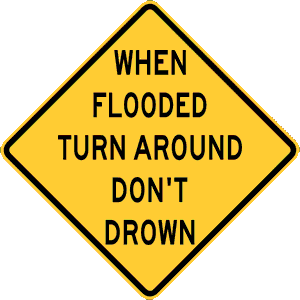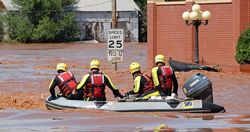Warning Signals
Heed the flood warning signs. Flash flooding usually occurs with brief, but intense, storms. Water may accumulate rapidly in low lying areas, hence the term "flash". Flooding may also occur with a long duration of rain, such as for multiple days in a row. Tropical weather systems, such as during hurricane season, can bring large amounts of rain to the Concord area in a relatively short period of time.
When a storm is imminent or occurring:
Know the terms for alerts and warnings:
-
Flood watch – rainfall is heavy enough to cause rivers to overflow their banks. Flooding is possible.
-
Flood warning – flooding is occurring or very likely to happen in an affected river, lake or tidewater area. If told to leave, do so immediately.
-
Flash flood watch – flash flooding in specified areas is possible. Be alert! You may need to take quick action.
-
Flash flood warning – flash flooding is occurring or is likely to happen along certain streams and select areas. Get to a safe place immediately!
Stay informed. Monitor the news or listen to weather radio.
Plan for how you will stay informed if there is a power outage.
Sign up for WaterAlerts from the National Weather Service to receive text or email messages when a stream in your area is rising to flood level. Simply zoom in to a site on the interactive map, select the desired gaging station, and click "WaterAlert" to sign up to receive alert messages pertaining to that gaging station.
What to do During a Flooding Event
1. Don't drive through flooded areas.
 In Concord, when flooding begins to occur, it generally affects low-lying roads that are subject to high water levels. We don't often think about the power of water, but nevertheless, water is a very powerful force. A small car can be swept away with just 12 inches of flowing water, and 18 inches can sweep away even some of the largest passenger vehicles. Additionally, if water obstructs the exhaust system of the vehicle, the engine can stall and make matters even worse. In most cases, it is difficult for drivers to determine how deep water actually is. So, the best policy is to "turn around" and not risk driving through flooded areas. In Concord, when flooding begins to occur, it generally affects low-lying roads that are subject to high water levels. We don't often think about the power of water, but nevertheless, water is a very powerful force. A small car can be swept away with just 12 inches of flowing water, and 18 inches can sweep away even some of the largest passenger vehicles. Additionally, if water obstructs the exhaust system of the vehicle, the engine can stall and make matters even worse. In most cases, it is difficult for drivers to determine how deep water actually is. So, the best policy is to "turn around" and not risk driving through flooded areas.
2. Know the evacuation routes.
Having an advanced plan is the best way to avoid a bad situation. Residents who live near flood-prone areas should have an evacuation route planned. If the flooded route is blocked, know the alternate routes that will take you and your loved ones out of the area. If flood waters come close to or enter your house, use an escape plan that you have prepared.
3. Safety tips during an evacuation

If a flood is likely in your area:
-
Listen to the radio or television to learn what to do.
-
Know that flash flooding can occur. If there is any possibility of a flash flood, move quickly to higher ground. Do not wait to be told to move.
-
Know that streams, drainage channels, canyons and other areas can flood quickly. Flash floods can happen in these areas with or without typical warnings.
If you must leave:
-
Secure your home. If you have time, bring in outdoor furniture. Move important items to an upper floor.
-
Turn off water, gas, and power at the main switches or valves if told to do so. Disconnect electrical appliances. Do not touch electrical equipment if you are wet or standing in water.
-
Do not walk through moving water. Six inches of moving water can make you fall. If you have to walk in water, walk where the water is not moving. Use a stick to check the firmness of the ground in front of you.
-
Do not drive into flooded areas. If floodwaters rise around your car, leave the car and move to higher ground if you can do so safely. You and the vehicle can be swept away quickly.
-
Do not camp or park your vehicle along streams, rivers or creeks, particularly during threatening weather.
-
It is recommended to take your pets with you. It may be some time before you can return.
4. Shelters
During a severe storm event, shelters may be opened to assist citizens with basic needs. Please monitor communication networks to find out where shelters are in your area. In some cases, the fire station locations in Concord will be opened as temporary shelters. These may include:
-
Fire Station #3 - 100 Warren C. Coleman Blvd.
-
Fire Station #7 - 250 International Dr NW
-
Fire Station #8 - 1485 Old Charlotte Rd SW
-
Fire Station #9 - 1020 Ivey Cline Rd
What to do Before a Flooding Event
Being prepared is a process of planning for an event, and implementing the components of the plan at the right time. To prepare for a flood:
-
Build an emergency kit and know how to use it.
-
Make a family communications plan.
-
Do not build in a floodplain without obtaining a permit from the City of Concord.
-
Raise up the furnace, water heater and electric panel in your home if you live in a high flood risk area.
-
Think about putting in "check valves" to prevent flood water from backing up into the drains of your home or business.
-
If you can, build barriers to stop floodwaters from entering the building. Seal walls in basements with waterproofing compounds.
What to do After a Flooding Event
Document your damage
Use photos and/or videos to help document damage. Retain samples of carpet, wallpaper, furniture upholstery, window treatments, and other items where the type of material may impact the amount payable on the claim. Take photos of appliances (washers, dryers, refrigerators) and write down make, model, and serial numbers. If possible, retain copies of receipts for these items.
Mold and Cleanup
Minimize the growth of mold as much as possible. NFIP flood insurance policies will not cover mold damage if a policyholder has access to the property and yet fails to take action to prevent the growth and spread of mold. Download this guide to learn more about mold cleanup: Homeowner's and Renter's Guide to Mold Cleanup After Disasters
File a Claim
Report your loss immediately to your insurance agent. Have the following information available when reporting your claim:
Register for FEMA assistance at DisasterAssistance.gov
Prepare for Your Inspection
Enter the building only if it is safe. Document the damage using photos. Prepare the area for your insurance adjuster to visit. Contact the building inspections department if your property was substantially damaged or if you need to obtain a building permit to repair the building.
Work with Your Adjuster
Your adjuster will show you their official identification and supply you with their contact information. You should expect to receive an explanation of the NFIP flood claims process. The adjuster will inspect your property and take photos. They will explain what an advance payment is and how you can get one.
Create a Proof of Loss
Your adjuster will assist you in preparing a "Proof of Loss" statement, which is a sworn statement indicating the amount you are claiming. The proof of loss must be filed within 60 days of the date of loss.
For More Information
Flood Prone Areas
Flood-prone areas are those that are susceptible to flooding or are likely to flood. These areas are mapped on the Flood Insurance Rate Maps (FIRM), and are made available by the Federal Emergency Management Agency (FEMA) and the State of North Carolina's Floodplain Mapping Service.
The City of Concord Planning Department is a repository of these maps. Copies of the maps are available for download and for viewing at the department.
To Learn More
Concord Natural Hazard Mitigation Plan
|